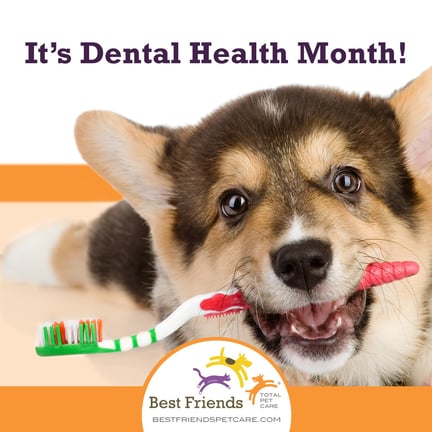February is Pet Dental Health Month so we wanted to take this opportunity to remind you of the importance of keeping up with the dental health of our furry family members. Luckily for us, we recently had a veterinary dental specialist join our Best Friends family. His name is Dr. Gary Goldstein and, not only is he our new Chief Medical Officer, he is a Fellow of the Academy of Veterinary Dentistry and is certified in Veterinary Dentistry and Oral Surgery.
We asked Dr. Goldstein a few questions recently to help us all become better educated about dental disease in our pets and the importance of pet dental health.
1. What are the most common diseases that you see in dogs and cats?
Periodontal disease is the most common infectious disease in adult dogs. It affects 91% of dogs and 85% of cats over 2 years of age and is a cyclical, progressive inflammatory disease that causes destruction of the tissues that support the teeth (the periodontium). Locally, periodontal disease can result in pain, tooth loss, social isolation of pet, poor nutrition due to pain or decreased chewing function, and even jaw fractures. Left untreated, this chronic inflammation can lead to problems with the liver, kidneys, and heart.
Periodontal disease can be prevented with good oral hygiene and regular professional veterinary dental care.
2. What is the number one thing that an owner can do at home to help improve their pet’s oral health?
Daily brushing with a soft bristle tooth brush and tooth paste made specifically for dogs and cats is a critical part of oral care at home. If you are uncertain about how to brush your dog or cats teeth, ask your veterinarian or a member of the vet care team to show you. They can also counsel you on ways to make the experience a positive one for you and your pet which will make it easier to maintain a good oral health regimen at home.
As with all other aspects of your pet’s health, be proactive and observant. Owners, as well as veterinarians, technicians, and other pet care givers, all need to be aware of clinical signs and symptoms of dental disease. Some of these signs can include: bad breath, decreased appetite, weight loss, bleeding from the gums, oral discomfort, facial swelling, drooling, pawing at the mouth, and head shyness. Some pets can have dental disease and not show any signs at all which is why regular veterinary exams are so important.
3. Are there effective diets or toys that can help keep pets’ teeth clean or is it all marketing hype?
Sadly, there is no magic treat or diet. The best defense against dental disease is still daily tooth brushing with a soft bristle tooth brush and toothpaste made specifically for dogs and cats. Dental chews and veterinary prescription diets may help control plaque and calculus via chemical or mechanical means or both; however, these are still not a substitute for daily brushing. Cow hooves, bones, antlers, hard plastic toys, and nylon style bones can fracture teeth and should be avoided. A good way to determine if a product or diet meets its label claims is to look for the Veterinary Oral Health Council (VOHC) seal. The VOHC reviews results and data voluntarily submitted by the manufacturer. To learn more about the VOHC and how it evaluates veterinary dental products visit www.avdc.org.
4. How often should dogs and cats have a dental exam and professional dental cleaning?
Annual or bi-annual exams will be required to prevent oral disease and maintain dental health.
How often your pet will require a professional dental cleaning will depend on how old they are when you begin, their breed (small breed dogs tend to require more frequent visits), whether they have any concurrent illnesses (e.g., diabetes, immune disease, or kidney disease), and how diligent you are about caring for their teeth at home. The American Animal Hospital Association (AAHA) suggests that the first professional dental cleaning begin in cats and small dogs at the age of 1, and medium to large breed dogs to begin at age 2. Professional dental cleanings will generally be required on an annual basis; however, in cases where there is advanced periodontal disease or often times in small breed dogs, twice a year professional dental cleaning may be required. Because this will require general anesthesia, your veterinarian will perform a thorough physical examination and obtain some baseline blood tests to make sure that your pet is in the best possible health before undergoing a dental cleaning.
5. When should referral to a veterinary dentist be considered?
If your veterinarian finds that your pet has an abscessed tooth or a fractured tooth in which the root is exposed, referral to a veterinary dentist for root canal therapy should be considered. Patients that have advanced periodontal disease, advanced oral-maxilla facial tumors, or patients who require crowns or restorations, orthodontics, or who have other challenging oral health issues, may benefit from referral to a veterinary dentist.
Treatment of periodontal disease is not a once in a lifetime event for your pet, but rather an ongoing treatment program throughout all stages of their life. Being proactive and diligent about the dental health of your furry family members will minimize the risk of serious illness or tooth loss down the road.






